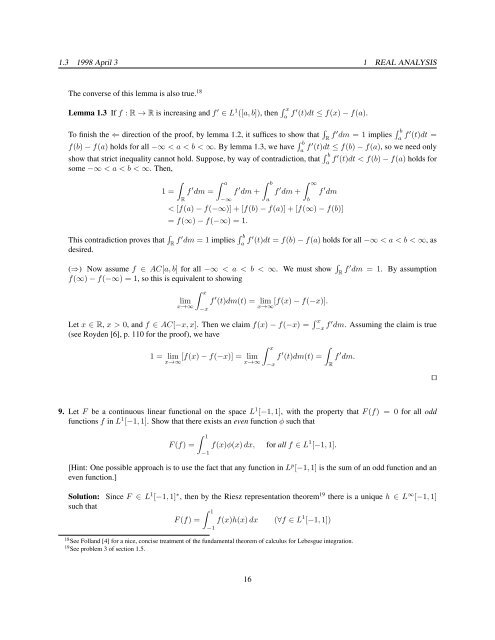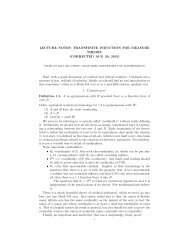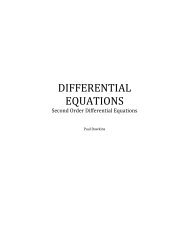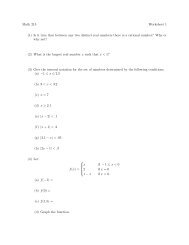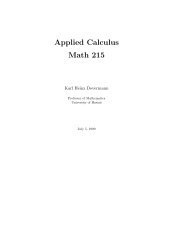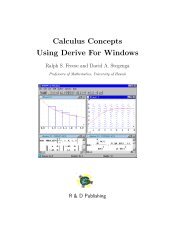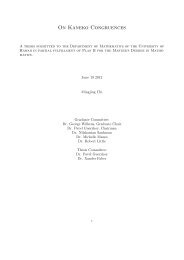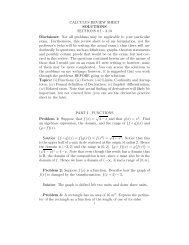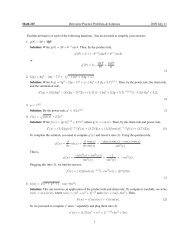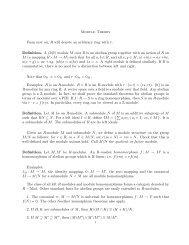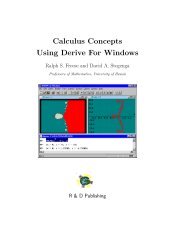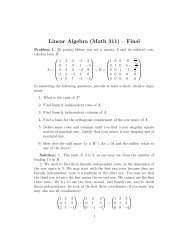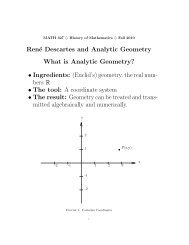Problems and Solutions in - Mathematics - University of Hawaii
Problems and Solutions in - Mathematics - University of Hawaii
Problems and Solutions in - Mathematics - University of Hawaii
Create successful ePaper yourself
Turn your PDF publications into a flip-book with our unique Google optimized e-Paper software.
1.3 1998 April 3 1 REAL ANALYSIS<br />
The converse <strong>of</strong> this lemma is also true. 18<br />
Lemma 1.3 If f : R → R is <strong>in</strong>creas<strong>in</strong>g <strong>and</strong> f ′ ∈ L 1 ([a, b]), then x<br />
a f ′ (t)dt ≤ f(x) − f(a).<br />
To f<strong>in</strong>ish the ⇐ direction <strong>of</strong> the pro<strong>of</strong>, by lemma 1.2, it suffices to show that <br />
R f ′ dm = 1 implies b<br />
a f ′ (t)dt =<br />
f(b) − f(a) holds for all −∞ < a < b < ∞. By lemma 1.3, we have b<br />
a f ′ (t)dt ≤ f(b) − f(a), so we need only<br />
show that strict <strong>in</strong>equality cannot hold. Suppose, by way <strong>of</strong> contradiction, that b<br />
a f ′ (t)dt < f(b) − f(a) holds for<br />
some −∞ < a < b < ∞. Then,<br />
<br />
1 =<br />
R<br />
f ′ dm =<br />
a<br />
−∞<br />
f ′ dm +<br />
b<br />
a<br />
f ′ dm +<br />
∞<br />
b<br />
f ′ dm<br />
< [f(a) − f(−∞)] + [f(b) − f(a)] + [f(∞) − f(b)]<br />
= f(∞) − f(−∞) = 1.<br />
This contradiction proves that <br />
R f ′ dm = 1 implies b<br />
a f ′ (t)dt = f(b) − f(a) holds for all −∞ < a < b < ∞, as<br />
desired.<br />
(⇒) Now assume f ∈ AC[a, b] for all −∞ < a < b < ∞. We must show <br />
f(∞) − f(−∞) = 1, so this is equivalent to show<strong>in</strong>g<br />
x<br />
lim f<br />
x→∞<br />
−x<br />
′ (t)dm(t) = lim [f(x) − f(−x)].<br />
x→∞<br />
R f ′ dm = 1. By assumption<br />
Let x ∈ R, x > 0, <strong>and</strong> f ∈ AC[−x, x]. Then we claim f(x) − f(−x) = x<br />
−x f ′ dm. Assum<strong>in</strong>g the claim is true<br />
(see Royden [6], p. 110 for the pro<strong>of</strong>), we have<br />
x<br />
1 = lim [f(x) − f(−x)] = lim<br />
x→∞ x→∞<br />
f ′ <br />
(t)dm(t) = f ′ dm.<br />
9. Let F be a cont<strong>in</strong>uous l<strong>in</strong>ear functional on the space L 1 [−1, 1], with the property that F (f) = 0 for all odd<br />
functions f <strong>in</strong> L 1 [−1, 1]. Show that there exists an even function φ such that<br />
F (f) =<br />
1<br />
−1<br />
−x<br />
f(x)φ(x) dx, for all f ∈ L 1 [−1, 1].<br />
[H<strong>in</strong>t: One possible approach is to use the fact that any function <strong>in</strong> L p [−1, 1] is the sum <strong>of</strong> an odd function <strong>and</strong> an<br />
even function.]<br />
Solution: S<strong>in</strong>ce F ∈ L 1 [−1, 1] ∗ , then by the Riesz representation theorem 19 there is a unique h ∈ L ∞ [−1, 1]<br />
such that<br />
F (f) =<br />
1<br />
−1<br />
f(x)h(x) dx (∀f ∈ L 1 [−1, 1])<br />
18 See Foll<strong>and</strong> [4] for a nice, concise treatment <strong>of</strong> the fundamental theorem <strong>of</strong> calculus for Lebesgue <strong>in</strong>tegration.<br />
19 See problem 3 <strong>of</strong> section 1.5.<br />
16<br />
R<br />
⊓⊔


